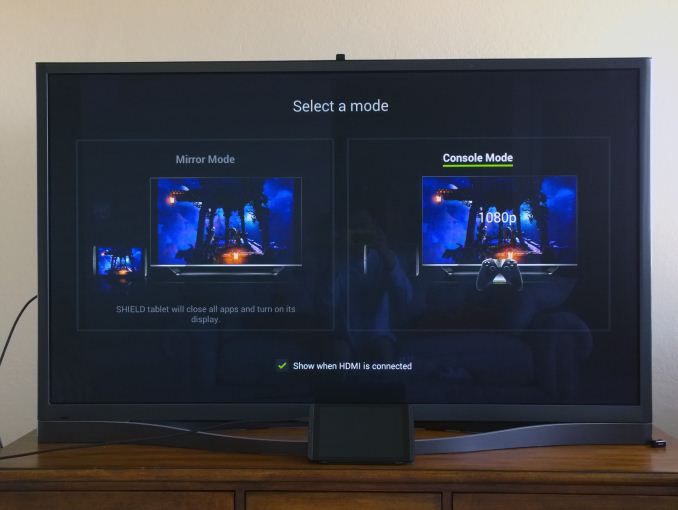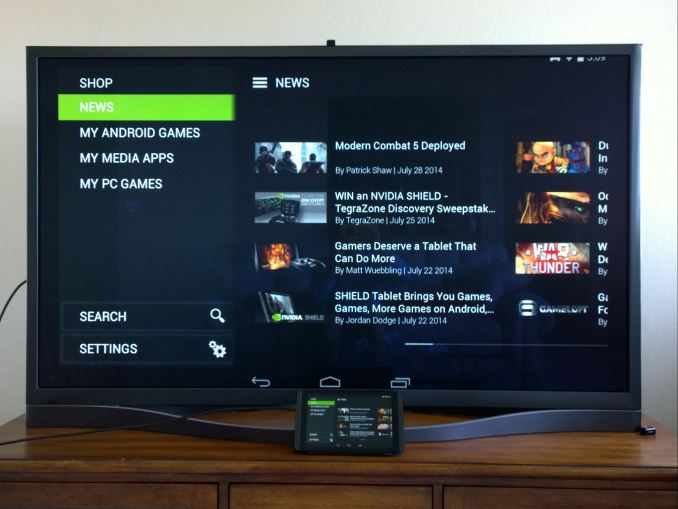The NVIDIA SHIELD Tablet Review
by Joshua Ho on July 29, 2014 9:00 AM ESTSoftware
In the UI department, there’s not too much to talk about. Much like Motorola, NVIDIA has stuck to using the AOSP UI design. Of course, there are plenty of NVIDIA-specific applications, but I didn’t run into any issues using the tablet to do everyday tasks. In this respect, things have improved massively over Shield portable. Because this tablet works in both portrait and landscape, there aren’t any issues with applications that force portrait mode like there were with the Shield portable. In normal tablet usage, it works as one might expect, with no real perceived lag throughout the UI. Of course, this is when compared to other Android devices. There are still frame drops involved in scrolling through lists and similar areas where Android has traditionally struggled to stay smooth, but Android L should fix this issue for the most part.
DirectStylus 2
The real value that the Shield tablet brings as a tablet is the stylus functionality. DirectStylus 2 is definitely much, much better than any other capacitive stylus on the market. The tip allows for precise control and it’s definitely responsive to changes in pressure. For the most part, there are only small issues here. Because the stylus is capacitive, it’s not really possible to have a floating pointer the way Wacom styluses do. In addition, I noticed that I need to lift the stylus a bit more than I might with pencil and paper in order to start a new letter or word or else my words would start to flow together. For the most part though, it works well enough, and the inking latency is low. Unfortunately the issue here is more of ecosystem than hardware, as most stylus-enabled applications aren’t nearly as robust as OneNote on Windows x86.
Console Mode
Of course, the real question here is whether the gaming side is worth the price premium. NVIDIA has gone all out on this area, and their efforts are split up into multiple aspects. The first is the TV interface/console mode, then the gameplay recording feature known as ShadowPlay. Finally, there’s the aspect of GameStream and GRID, which make it possible for games to be played on the tablet that otherwise wouldn’t work due to the compute requirements.
The TV interface effectively boils down to Shield Hub and Google Now, although it’s fully possible to use the full tablet UI as desired in this mode. In the hub, launching games and various applications like YouTube and Netflix is rather simple compared to the more cumbersome full Android UI as they have their own category in Shield Hub. In addition, launching applications through Google Now works as expected. Overall, there aren’t any friction points here. It works as well as one could expect. There is a strong reliance on voice input in general, but it’s much better than trying to type with a controller and better than most smart TV experiences. While the TV interface is mostly targeted towards enabling a console gaming experience, YouTube and Netflix both work great in this mode. NVIDIA has also gone through the necessary DRM certification process to allow for 1080p Netflix streaming. In essence, this device is already ready to serve as an Android TV device.
ShadowPlay
ShadowPlay, which we first saw in GeForce GTX GPUs, is also another major advantage that NVIDIA brings to the table for software experience. In short, this leverages the hardware H.264 video encoder that is on the Tegra K1’s Kepler GPU to provide video capture of gameplay or anything else displayed by the tablet. There are three possible options for video capture. The first is Twitch broadcasting, something that NVIDIA is quite proud of as they are the first to implement such a feature in an Android tablet. While I personally don’t stream on Twitch, a demo of Twitch broadcasting in the initial launch briefing worked without any visible quality issues in either audio or video.
There are two other recording modes. One is a standard start/stop recording feature, but the other is ShadowPlay/Auto Recording. In short, this keeps anywhere from the past minute to 20 minutes in video. This makes it possible to set and forget about the recording feature rather than constantly managing recordings in manual mode. All of these modes can use the tablet’s microphone and front facing camera for commentary purposes as needed. Local recordings seem to have a maximum of 1080p30, and Twitch broadcasts are limited to 720p30.
While those are the technical details, it’s a painless process. All the user has to do is long press the back button on the controller and select what kind of a recording they’d like to do (Twitch, Auto, Manual, Screenshot) and that’s it. I can see significant potential in this area especially if this device takes off as a gaming platform.
















174 Comments
View All Comments
Stuka87 - Tuesday, July 29, 2014 - link
I think the tablet on its own is decent. Although it is very heavy for its size (Which BTW this review does not mention its weight anywhere).The controller is what I end up scratching my head over. In their release photos they show a girl gaming with the tablet, but sitting like 3ft away. As if being that far away would be enjoyable.
One other thing that is not clear, if the tablet is NOT on wifi, will the controller still work? The article makes it sound like you have to be on wifi.
Friendly0Fire - Tuesday, July 29, 2014 - link
WiFi *Direct* is a straight connection between the tablet and the controller using the WiFI protocol. It most certainly doesn't need a network to work.Stuka87 - Tuesday, July 29, 2014 - link
Hm, ok. But he specifically said it depends what type of wifi network you are on.lmcd - Tuesday, July 29, 2014 - link
That's for the connection band. Meaning that if one of the two Wi-Fi bands is in use for Wi-Fi, then the other one is the one that'll be used for the Wi-Fi direct.halca - Tuesday, July 29, 2014 - link
Really? That's it for the directstylus review section? I'm disappointed. I hoped to see more comparison between the old and new, and compared to wacom's tech on samsung note line.scbundy - Tuesday, July 29, 2014 - link
Shame about the screen, but with my old Nexus 7 broken and me looking for a gaming tablet replacement, this one appears to fit the bill perfectly. Especially since my gaming PC has a 780 GTX. Can't wait to try it out.dabotsonline - Tuesday, July 29, 2014 - link
"In essence, this device is already ready to serve as an Android TV device."I thought that Google are mandating a very specific UI design for Android TV devices - one which is very different from this? Do you have any inside info regarding the final version this fall / autumn, Josh?
aamir147 - Tuesday, July 29, 2014 - link
I think he means nvidia can eventually add an android TV mode when connecting via hdmi just like you can get a console mode.SpartyOn - Tuesday, July 29, 2014 - link
Personally, I love my Shield Portable (or whatever they're calling the 1st Gen device). Sitting in bed or on the couch streaming the game I just turned off at my desk is fantastic. It's also the best Android emulator device out there.The recent updates to allow outside the home streaming (which this article incorrectly states as only allowing in-home; please change) and 1080p Console Mode streaming via wired Ethernet, have made this a killer mobile gaming device. Instead of carting my mITX build back and forth when I want to play a game via controller on my HDTV, I can now simply hook up the Shield and stream the game, in full 1080p, to the TV and can hook up an XBOX 360 wireless controller with USB OTG. No more hauling a computer around the house or having to settle for a laptop! Seriously awesome.
My wife and I continuously fight to use the Shield when heading to bed, she for her emulators and me for streaming from my gaming rig. I REALLY want to pick up another one so that she can have her own, so I was hoping this was going to be a self-contained device like the 1st Gen, just with the K1 and maybe some weight balancing, an extra miniUSB port, and a 6" screen with less bezel (the bezel with the 5" is HUGE and I'm sure they could creatively get a slightly bigger screen in there).
Unfortunately, the new Shield device as a tablet is... underwhelming. Sure it has snazzy bells n' whistles for a tablet, but with the larger form factor and lack of handholding ease, this really kills a lot of its portability. I prefer the fully contained controller/screen of the original; plus, it was different and really created a new market. Now it's just another tablet in a crowded field. Seems like a dumb strategy to me.
Until they release a refreshed Shield Portable with the K1, I'll be keeping my money. Kudos to NVIDIA though for the 1st Gen device - I love it.
fivefeet8 - Tuesday, July 29, 2014 - link
Unfortunately, you're probably in the minority at this point and I do understand why some would prefer it that way. One of the reasons I didn't get the original shield is because you couldn't do much else with it besides gaming. Even though I loved the hardware and software, I wanted something that could encompass more. Something I could use for both work and play on mobile. The new Shield Tablet fits that almost perfectly.